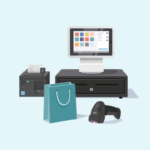What’s the secret behind building a thriving retail business? A loyal and growing customer base? High-quality products at a price your target customers are willing to pay? Outstanding customer service?
Of course! Those things are critical. But, they’re not the secret. Accomplishing strong sales, customer growth, and loyalty all depend on one thing – having the right inventory management in place. Without an effective inventory process, you end up with too many, too few, or completely wrong items. And, all of those can cost you big.
Lost sales due to products being out-of-stock and unavailable when the customer wanted to purchase them cost North American retailers $145 billion in 2018. If the huge number feels difficult to relate to your business, try this. Twenty percent of Amazon’s retail revenue comes from buyers who first attempted to buy the product at a local store but found it out-of-stock. (Source)
All inventory systems are not created equal
When you’re first starting out, there may be a window of time where you can get by with tracking inventory by spreadsheet. But that’s never optimal for long-term success. Rather, inventory management should be a key consideration when you select your Point of Sale (POS) system. However, while most POS systems handle retail transactions and tie purchases back to inventory, they’re not all created equal when it comes to inventory management capabilities.
Your POS should enable fundamental inventory management. You should be able to set alerts that let you know when items are running low. It should be easy to add new items as shipments come in. And, your POS should track and account for any backorders.
When you have the fundamentals in place, you not only ensure popular products are available to customers, but you’re also able to quickly identify underperforming items. Real-time access to inventory informs your buying decisions, helping you forecast the right stock to keep on hand while maintaining cash flow.
A good POS system will go way beyond basic inventory management. Here are three must-have inventory capabilities retailers need to thrive in the 2020s.
Must-have #1: Robust reporting
More than ever before, retailers succeed when they can easily access and effectively leverage data. In an on-demand world, having hard-to-find items on hand, in the right size or style, can be a distinct – and vital – differentiator over large and online competitors. Customers report that when they make a trip to a brick and mortar store with the intent to purchase a specific item, they encounter “out of stock” situations once in every three visits. (Source)
Being a resource your customers can count on to have what they want, when they want it, means you can’t cross your fingers and guess. Today’s retailers have to move beyond tracking inventory to also analyze and interpret it in order to make data-driven decisions about purchasing, re-orders, and transfers.
A good POS system will provide standard “out-of-the-box” reports, along with the ability to also create more detailed, customizable reports when needed. For example, a regular report on the best and worst selling items will highlight opportunities to increase inventory and prevent over-ordering item-by-item, style-by-style, while also providing early identification to changes in customer buying behaviors.
POSIM combines POS with extensive inventory management capabilities, giving retailers easy access to a range of built-in report options, with the ability to customize them using filters and grouping. In addition, POSIM includes a powerful define-a-report feature so users can build completely custom reports via an easy-to-use interface.
Must-have #2: Tailored functionality
Retail inventories are complex. A one-size-fits-all POS isn’t practical. You need your system to line up with the specific needs and requirements of your business.
Whether you own a clothing boutique or a needlearts craft store, you’re likely to be managing an ever-changing inventory of thousands of SKUs representing a wide range of colors and styles. When you know exactly what you have, you can turn it into tailored upsell opportunities. For example, if a customer is buying yarn for a particular project, an employee can check the inventory at the point of sale and alert the customer that she may want to purchase an additional skein of the same color if inventory is low.
Plus, you can take the data to the next level of precision. Continuing the yarn example, the needlearts retailer can tailor the inventory tracking to not only track at the color level, but also the specific dye lot, adding valuable granularity. Other retailers, such as fabric stores, need to track items based on measurements – yards, short bolts, or fat quarters. Similarly, wine and liquor retailers need to track alternate units, like wine by the case, half case, and single bottle. The ability to tailor the POS system to fit these specific inventory needs is imperative.
With POSIM, retailers have a style matrix feature that enables them to accurately track products with multiple style attributes, providing increased visibility into their inventory in a way that makes the most sense for their business.
Must-have #3: Automation
One of the most important things your POS system must do is make tracking, analyzing, and acting on the compiled data simple. The best way to do that is through automated capabilities.
For example, a good POS system enables you to set alerts as items reach their reorder points. Based on the alert, you can easily see information on the prices you’ve paid with the vendor, so you’re able to quickly and accurately move forward and get the best deal. You’ll also want the option to automate your reorder process to ensure top-selling items are never out of stock by triggering orders with key vendors automatically.
Depending on your business, you may also need integrated inventory capabilities across multiple physical locations as well as e-commerce. POSIM is built with add-ons that eliminate redundant work and make it easy to accurately view quantities in total or by store, and transfer items from location to location as needed. Designed with brick-and-mortar stores in mind, POSIM offers fully-integrated e-commerce solutions that give retailers the tools they need to seamlessly track, maintain, and adjust inventory across channels. Make inventory management a competitive advantage. POSIM makes managing your inventory in a way that fits your business easy. To explore what’s possible, contact us for a demo.












